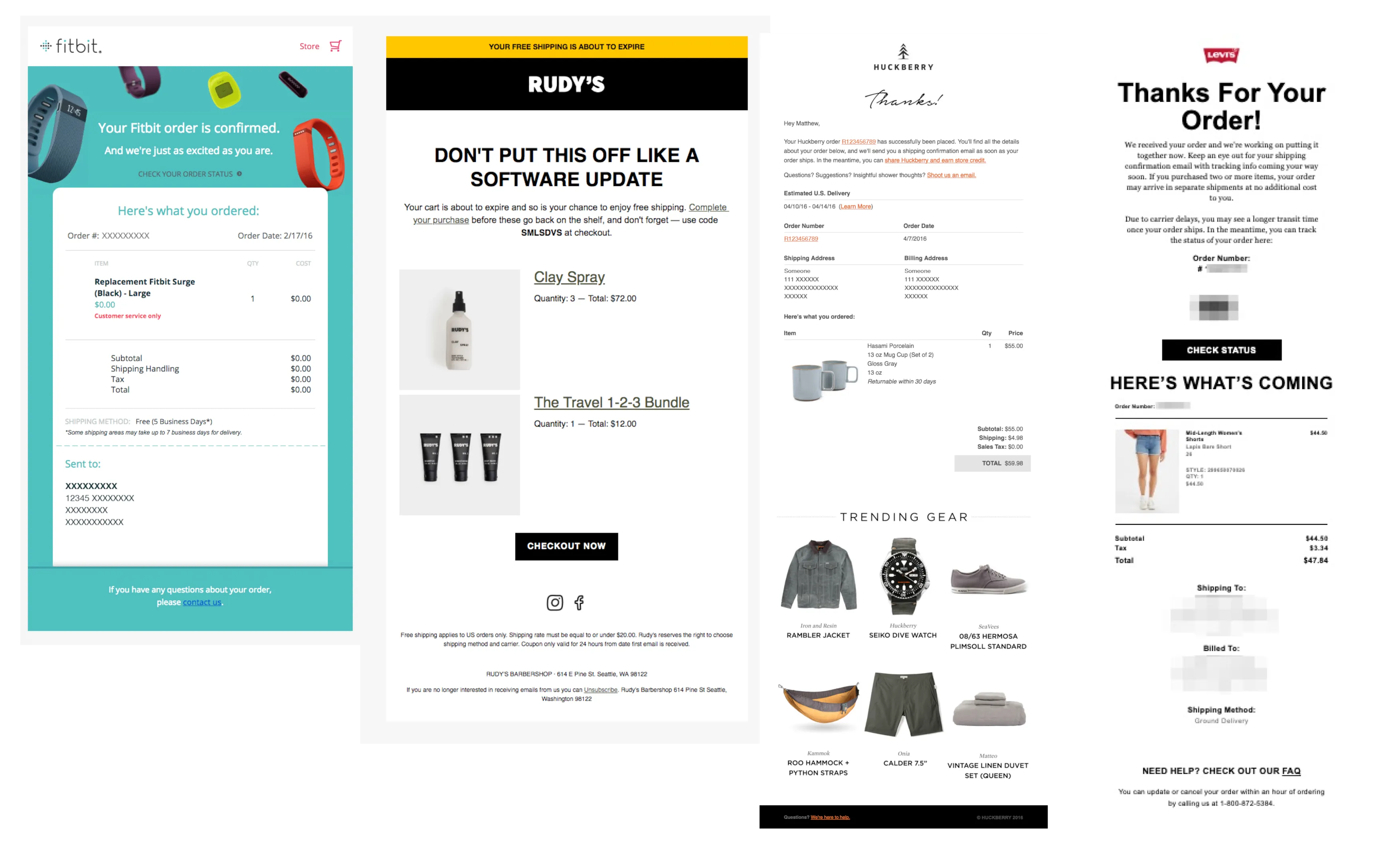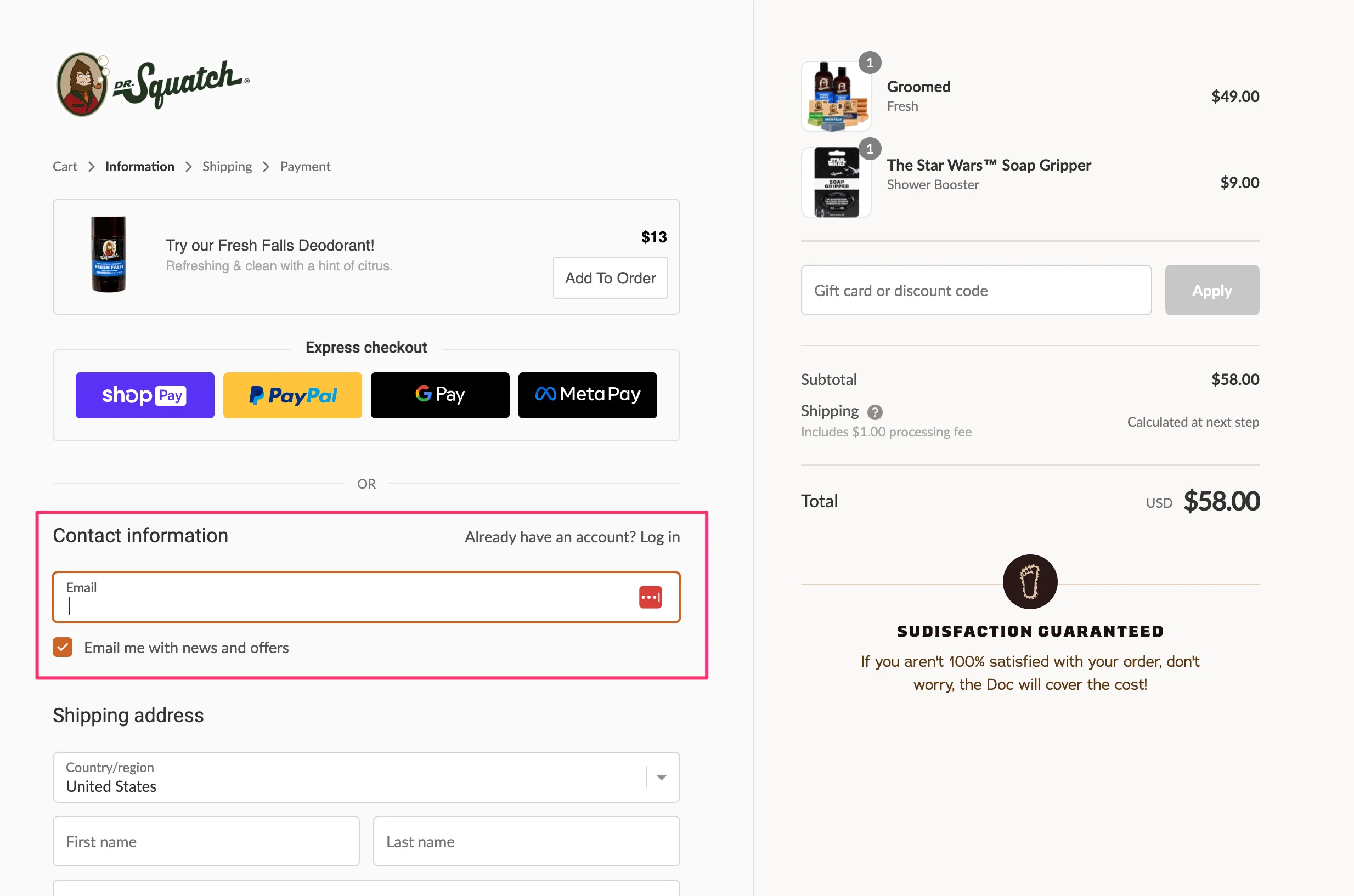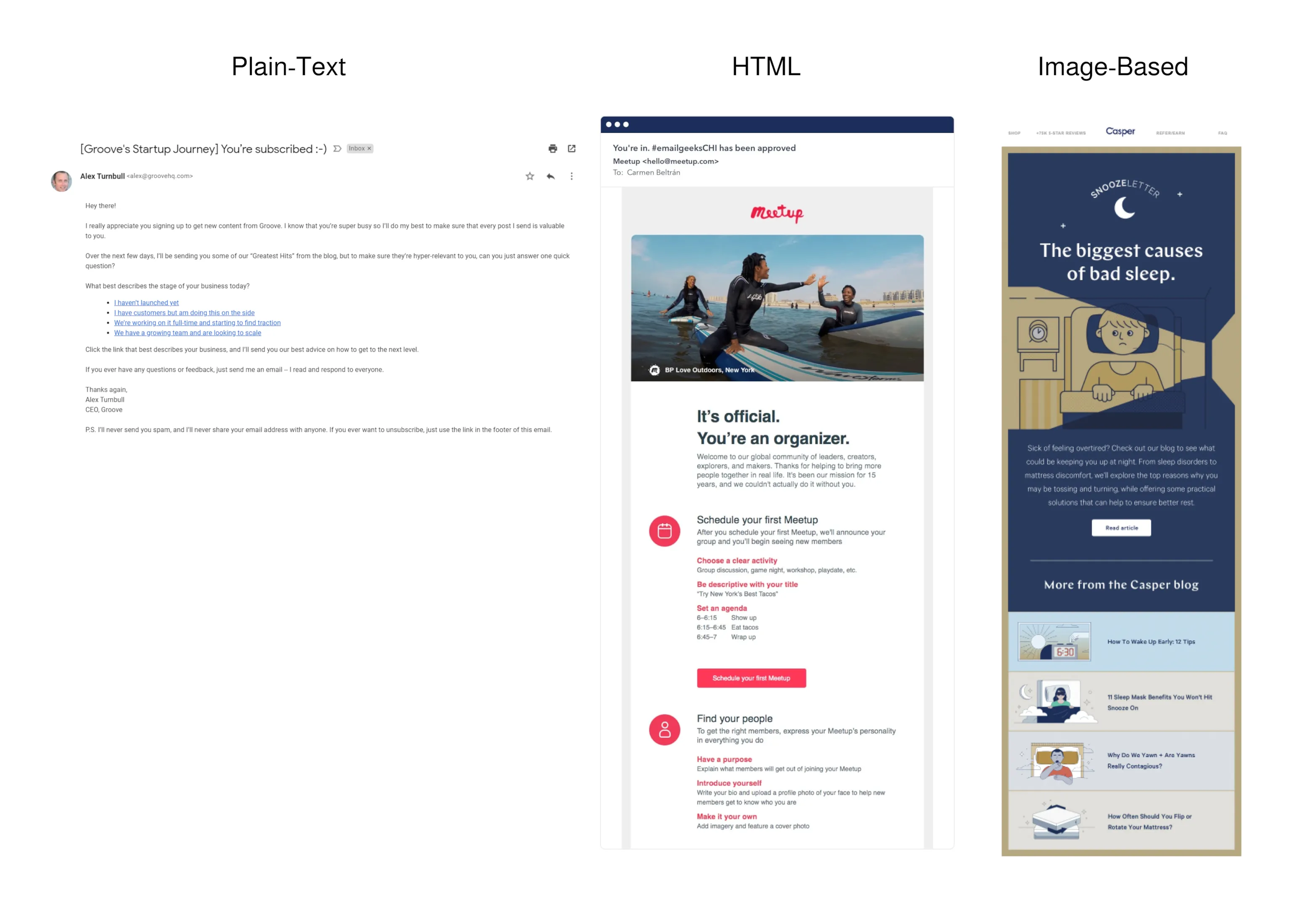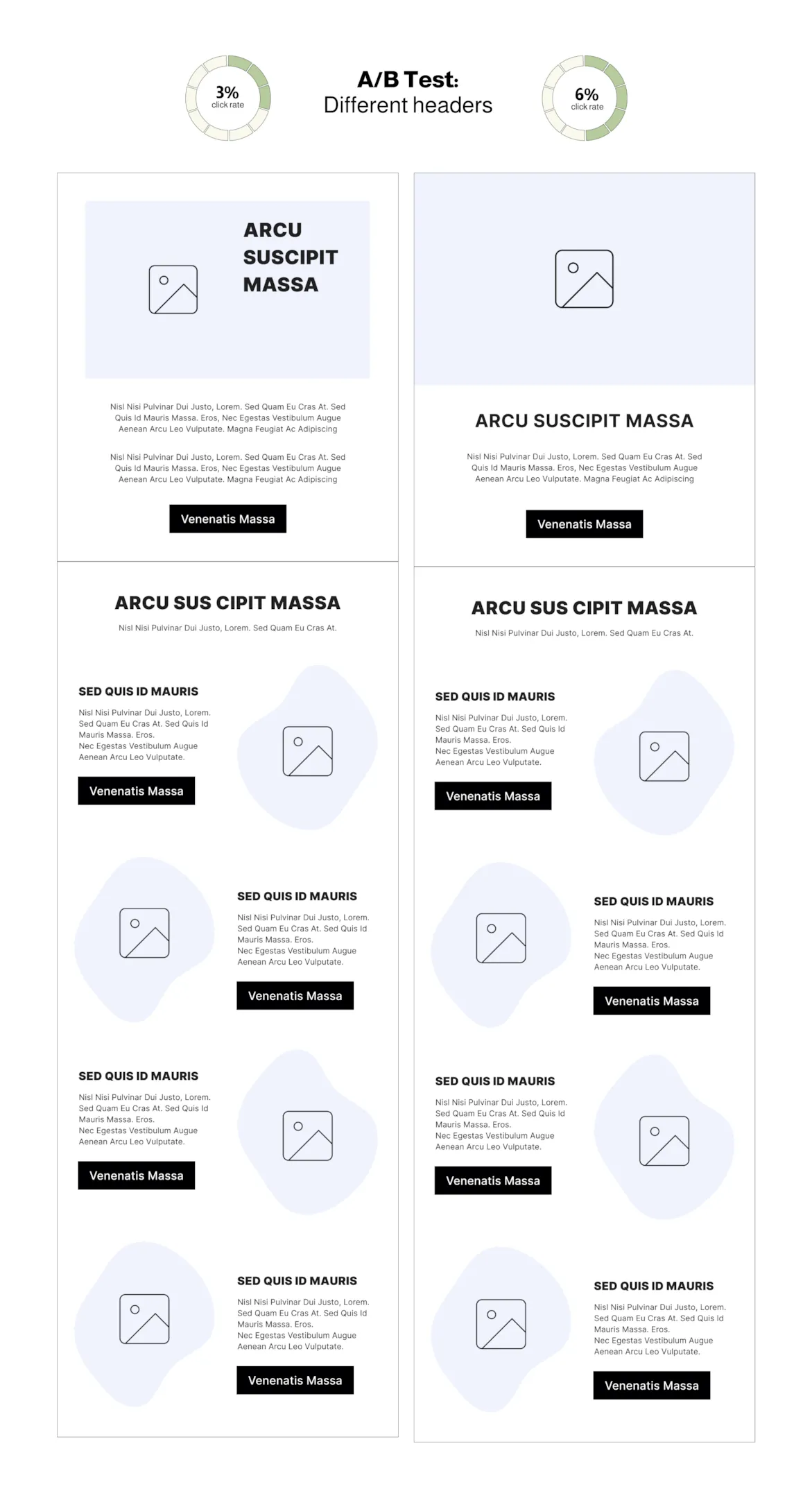Chapter 1: E-Commerce Email Marketing Basics
What is ecommerce email marketing? Ecommerce email marketing is the method of sending emails to generate sales, keep email subscribers engaged, and build customer loyalty for your ecommerce business. Email marketing is one of the most critical tools for your...
Tags
Tools
Level
Related Partners

What is ecommerce email marketing?
Ecommerce email marketing is the method of sending emails to generate sales, keep email subscribers engaged, and build customer loyalty for your ecommerce business.
Email marketing is one of the most critical tools for your ecommerce store because it is an “owned” marketing channel. In other words, your business owns the audience (your email list) and controls the content.
Unlike paid marketing channels (ie. Facebook, TikTok, Google) and earned marketing channels (ie. press coverage), email marketing gives you full control over your content, direct access to your audience and you don’t have to pay to reach them.
This makes email marketing a powerful marketing strategy to nurture, convert, and retain customers by building long-term relationships.
Why is email marketing important to grow your ecommerce store?
It has one of the highest return on investment (ROI): on average, e-commerce businesses earn $40 for every $1 spent on their email marketing and email marketing generates 20-30% of their business revenue.
This makes email marketing one of the most effective channels to generate revenue & convert customers.
Here are some of the ways email marketing can generate sales for your ecommerce store:
1. Promoting new products and promotions
Announce new product launches and promotions directly to your email list with email campaigns to generate awareness and sales.
2. Convert email subscribers into customers
Send a personalized welcome email to new subscribers to introduce them to your brand and your products with a Welcome Flow.
3. Educate & engage with new customers
Build customer loyalty by thanking customers after they purchase with automated email flows, such as post-purchase emails, that educate them on your brand and how to get the most out of your product.
4. Keep customers updated
Use transactional emails to keep customers notified on their order when it has been fulfilled, shipped, and delivered to improve your customer experience.
5. Get more repeat customers
Get more loyal customers and build long-term customer relationships by sending personalized cross-sell and upsell emails to introduce existing customers to new products or get them to upgrade to a higher tiered product.
6. Win back lost customers
Recapture lost revenue by showing your appreciation for lapsed customers re-rengaging them to return to make another purchase with a winback emails.
Fundamentals of Ecommerce Email Marketing
Types Of Emails
1. Transactional Emails
Transactional emails are a type of automated email that is sent specifically to alert customers or send them key information about their purchase on your online store. Unlike email marketing campaigns and flows, transactional emails are functional and related to their order, such as email receipts, order confirmations, order delivered emails.
SendGrid describes the difference between transactional emails and marketing emails as this: “transactional emails contains information about an action the recipient has already taken, while a marketing email intends to drive the recipient toward an action you want them to take”.

2. Promotional Email Marketing Campaigns
Promotional emails are a type of email marketing campaign designed to drive sales for a promotional offer. However, promotional emails can also be used to promote the launch of a new product or a collection.
Examples of promotional emails can include a sitewide 4th of July sale, the launch of new products in your Winter Collection, a free gift during Mother’s Day, or a 20% off Spring Sale.
3. General Email Marketing Campaigns
General campaigns are a type of ecommerce email marketing campaign designed to engage customers, drive sales, and/or nurture your audience. Unlike promotional emails, general campaigns typically don’t include any promotion or sale. Rather, they focus on sharing relevant content that your audience is interested in and introduce them to different products.
Examples of general campaigns include a weekly newsletter, blog roundup of your top content, listicles featuring tips or a product highlight educating customers on the features and benefits of your product.
4. Email Marketing Flows
Email Flows (also known as drip campaigns, triggered emails, evergreen emails, and lifecycle emails) are a type of automated emails that are sent when someone takes a certain action. This is often one of the biggest areas of opportunity for e-commerce brands to generate revenue. Many e-commerce brands have less than 20% of the built for their business and are leaving $100,000+ on the table.
Check out the most comprehensive full funnel download we created with Fermat & Ecom Experts to build your key email marketing flows.
Examples of email flows include a welcome email for new subscribers, cart abandonment emails to recover abandoned carts, and post-purchase emails to thank customers.

Other Email Marketing Basics
5. List Building
Your email list is one of the most important parts to successful email marketing. After all, you’ll need an audience to send emails to! Your email list is the list of people who have subscribed to receive emails from your ecommerce business. Most online stores build their email list through:
-
- Website Pop-Up: This is a form appearing to website visitors asking them to enter their email address, often to receive a discount code for their first purchase.

• Checkout Sign-Up: This is the form to collect the email address of customers as they’re completing checkout, where they’re asked to opt-in to receive marketing emails.

Other methods of building your email list include giveaways, quizzes, lead magnets, exit intent pop-ups, and footer email captures.
6. Email Design
Email design refers to the content of your email which includes the email layout (also known as email structure, email wireframe or email template), copywriting, and design. Great email design is an important part of improving your email marketing performance because it determines how well your emails engage and convert your audience.
There are three types of emails: plain-text emails, HTML emails & image-based emails. Most ecommerce email marketing campaigns use image-based emails to convey the brand in a more visually engaging way for audiences. However, plain-text and HTML emails often improve deliverability and can be useful to your email marketing strategy.

Most email marketing services include pre-made templates that you can use to easily create beautiful, optimized email designs. A tool like Backbone can also help you optimize your email design by providing customized email templates that optimize conversion and engagement.
7. A/B Testing
A/B testing (also known as split testing) is the method of systematically improving the performance of your ecommerce email marketing. It does so by sending two different variations of an email (variation A and variation B) to your email list, and seeing which performs better.
An example of A/B testing include sending two different variations of an email subject line, to see which one of the email marketing campaigns gets a higher open rate.

A/B testing is an important email marketing strategy to use to improve your open rates, click rates, and conversion rates. Though A/B tests only test one variable at a time, you can test multiple variables with multi-variate testing.
8. Audience Segmentation
Segmentation is the practice of splitting up your email subscribers into smaller groups based on different criteria. The most common types of customer segmentation are based on behaviors, demographics or characteristics.

A few examples of ways you can segment your audience is based on their location, level of customer engagement, whether they’ve made a purchase, or even what products they’ve purchased.
The main purpose of segmentation is to send personalized marketing messages for customers at each stage of their customer lifecycle. After all, repeat customers and loyal customers should receive different emails than new subscribers and potential customers.
Segmentation is an incredibly important part of having a sophisticated, and effective ecommerce email marketing strategy because it helps you deepen customer loyalty and customer relationships.
9. Email Marketing Terminology
When it comes to learning ecommerce email marketing, you’re likely going to run across a lot of terminology such as open rates, CTRs, cart abandonment, welcome email, blacklist & more. Being familiar with these terms will be important to be building an effective email marketing strategy.
See our Email Marketing Glossary for a list of all the e-commerce email marketing terms you’ll run into, explained.
Tools For Successful ECommerce Email Marketing
1. Email Service Provider (ESP)
To start email marketing, you’ll need an ESP (email service provider), which is a type of email marketing software that allows you to send emails to your list of email subscribers.There are a variety of email service providers that work well for ecommerce businesses and it isn’t a one-size-fits-all. It can depend on what you want to accomplish, how advanced your email marketing experience is, the size of your business, and which of the ecommerce platforms (ie. Shopify, WooCommerce etc.) that your ecommerce site is hosted on.Klaviyo is one of the few email marketing services that is built specifically for email marketing for ecommerce businesses. It also includes critical features you should look for in any email marketing service such as:
• Customizable, pre-made email templates to simplify the creation & design of emails
• Audience segmentation features to send personalized, targeted emails to different people
• Ability to send automated email campaigns to scale your email marketing
• Email capture opt-in forms to collect email addresses of new subscribers on your website
• Detailed reporting to measure the performance of your email marketing to generate insights on how to improve
• Ability to A/B test email campaigns to optimize your subject lines and content
Other options for great email marketing services include Active Campaign, Drip and more.
2. Project Management Tool
While a project management tool isn’t critical, you’ll find that once you start sending email campaigns regularly, there are a lot of different parts of the project to manage. You’ll need a project management tool that can help with:
• Building your email marketing campaign calendar
• Prioritizing the automated email campaigns you want to build each month
• Tracking the progress of the creation of each email: email brief, copywriting, design, and implementation
At Longplay, we use Asana as our project management tool to plan and track the hundreds of emails we’re creating each month.
3. Backbone
An email marketing tool like Backbone can help streamline your e-commerce email marketing efforts by automatically building your customized email marketing calendar & customer AI-generated email templates to create more high-converting emails for everything from a new product launch to an abandoned cart series.
4. Team
At a minimum, the anatomy of a successful e-commerce email marketing team usually consists of the following roles:
• an Email Marketing Manager/Strategist to build the ecommerce email marketing plan, build the email marketing calendar each month, develop new marketing strategies, and plan promotional emails
• an Email Copywriter to write the high-converting copy for each of the emails
• an Email Designer to create high-converting designs for each of the emails
Often, successful e-commerce email marketing teams will also have access to:
• a Technical Email Implementor to create and test the email in your email marketing service
• an Analyst to build reports to evaluate the effectiveness of different email marketing strategies

Best Practices & Common Mistakes For Ecommerce Email Marketing Strategy
1. Send email campaigns regularly
Consistency is key! Stick to a regular schedule when it comes to sending email campaigns.
One of the most common mistakes in ecommerce email marketing that online businesses make going months without sending an email to their email list. Over time, this can led to low engagement from your email list, and high unsubscribe or spam rates.
It’s better to send 1-2 emails a month regularly, than to not send any emails to your email subscribers for months, and suddenly hit them with lots of emails.
Your email marketing campaigns are the best way to maintain customer engagement with your brand and encourage customers to make more purchases.
2. Build email flows
Email flows are the highest ROI (return on investment) activity you can do when it comes to e-commerce email marketing.
For example, building one welcome email can have 50x more return in revenue than building one email campaign, because once it’s set live, it’ll continue generating revenue for you automatically.
Often ecommerce brands focus their email marketing strategy too much on campaigns, especially when teams are short on time or resources, which leads to email flows being neglected.
Set a goal to build or optimize at least 1-2 automated email campaigns each month to make sure you’re consistently improving your email flows.
See Part Beginner’s Guide To Email Marketing to learn more about building the critical flows to generate automated revenue for your e-commerce business.
3. Collect email addresses
Don’t be shy when it comes to collecting email addresses! At a minimum, you should have a welcome pop-up on your online store.
One of the most common mistakes e-commerce businesses make is only collecting email addresses at checkout, when a customer purchases.
Email marketing is one of the most effective channels to convert new subscribers into paying customers, so make sure you A/B test your website pop-up to maximize your opt-in rate.
4. Only sending email campaigns during promotions or product launches
Set a goal to consistently send at least 1-2 general email marketing campaigns each month.
One of the most common mistakes e-commerce businesses make is only emailing their list when they have a promotion offer or a new product launch to announce, which can hurt your customer relationships in the long-term.
Instead, build customer loyalty and nurture your potential customers by providing value through sharing content like educational emails, blog post roundups, or customer stories.
5. Run A/B Tests
A/B testing is one of the cornerstones to an effective email marketing strategy because it allows you to optimize your emails. A/B testing can be used to improve your open rate, click rate, purchase rate and even your average order value.
Most e-commerce brands don’t do enough A/B testing. In fact, you should aim to run an A/B test on every single one of your e-commerce email campaigns, even if it’s as simple as a subject line test.
6. Not tracking email marketing performance
As Peter Drucker says, “If you can’t measure it, you can’t manage it.”. In order to improve the performance of your email marketing strategies, you need to be able to measure and track the results.
One of the most common mistakes ecommerce brands make is trying to make their email marketing reporting too complicated in the beginning. It’s better to get started with something simple and be able to view your performance consistently.
Most email service providers have built-in reporting dashboards to allow you to see your key metrics. So set a regular time each week or month to review your email performance! We’ll dive into the metrics you should be looking at to track your email marketing success.
Tracking Ecommerce Email Marketing Success
When it comes to measuring your email performance, these are the key metrics you should be looking at. You can find this data in most email marketing software, or using analytics tools such as Google Analytics or Triple Whale.
See Part 8: Measuring Email Marketing Success of our Beginner’s Guide To Email Marketing to learn more about the basic and advanced metrics you should be tracking, why they’re important, and how to use the data to improve your email marketing strategy.
• Total email revenue: the total revenue generated from email marketing
• Email revenue %: the percentage of the total revenue of your online store that is attributed to email marketing
• Open rate: the percentage of people who received an email campaign and opened the email
• Click rate: the percentage of people who received an email campaign and clicked the email
• Conversion rate: the percentage of people who received an email campaign and ended up making a purchase
• Average order value: the average value of the orders placed that are attributed to email marketing
• Bounce rate: the percentage of emails sent that bounced from the recipient’s inbox
• Spam rate: the percentage of people who received an email campaign and marked it as spam
• Unsubscribe rate: the percentage of people who received an email campaign and opted-out of receiving more emails
• Email list size: the total number of people on your email list
2. Build email flows
Email flows are the highest ROI (return on investment) activity you can do when it comes to e-commerce email marketing.
For example, building one welcome email can have 50x more return in revenue than building one email campaign, because once it’s set live, it’ll continue generating revenue for you automatically.
Often ecommerce brands focus their email marketing strategy too much on campaigns, especially when teams are short on time or resources, which leads to email flows being neglected.
Set a goal to build or optimize at least 1-2 automated email campaigns each month to make sure you’re consistently improving your email flows.
See Part 3 and Part 4 of our Beginner’s Guide To Email Marketing to learn more about building the critical flows to generate automated revenue for your e-commerce business.
3. Collect email addresses
Don’t be shy when it comes to collecting email addresses! At a minimum, you should have a welcome pop-up on your online store.
One of the most common mistakes e-commerce businesses make is only collecting email addresses at checkout, when a customer purchases.
Email marketing is one of the most effective channels to convert new subscribers into paying customers, so make sure you A/B test your website pop-up to maximize your opt-in rate.
4. Only sending email campaigns during promotions or product launches
Set a goal to consistently send at least 1-2 general email marketing campaigns each month.
One of the most common mistakes e-commerce businesses make is only emailing their list when they have a promotion offer or a new product launch to announce, which can hurt your customer relationships in the long-term.
Instead, build customer loyalty and nurture your potential customers by providing value through sharing content like educational emails, blog post roundups, or customer stories.
5. Run A/B Tests
A/B testing is one of the cornerstones to an effective email marketing strategy because it allows you to optimize your emails. A/B testing can be used to improve your open rate, click rate, purchase rate and even your average order value.
Most e-commerce brands don’t do enough A/B testing. In fact, you should aim to run an A/B test on every single one of your e-commerce email campaigns, even if it’s as simple as a subject line test.
6. Not tracking email marketing performance
As Peter Drucker says, “If you can’t measure it, you can’t manage it.”. In order to improve the performance of your email marketing strategies, you need to be able to measure and track the results.
One of the most common mistakes ecommerce brands make is trying to make their email marketing reporting too complicated in the beginning. It’s better to get started with something simple and be able to view your performance consistently.
Most email service providers have built-in reporting dashboards to allow you to see your key metrics. So set a regular time each week or month to review your email performance! We’ll dive into the metrics you should be looking at to track your email marketing success.
A white-glove service built for success.
We've planned every part of your client experience so you know you're in good hands.
Related Posts

Post-Purchase Nurture Flow
The Post-Purchase Nurture Flow maintains engagement by thanking customers, educating customers on how to use the product & sharing content relevant to their challenges. It targets recent buyers, fostering a post-purchase relationship that enhances customer loyalty and lays the groundwork for repeat business.What’s A Post-Purchase Nurture Flow?A Post-Purchase Nurture Flow is the first few emails a customer gets after they make a purchase (besides transactional emails like an Order Confirmation). This is one of the most commonly underused but important emails for a DTC ecommerce brand because it builds brand loyalty with purchasers.The best way to keep customers is to make sure they have a great experience of your brand and products, so they return to make future purchases.That’s why building a great Post-Purchase Nurture flow is the first step to retaining more customers, getting more repeat purchases & increasing customer lifetime value (LTV). An effective Post-Purchase Nurture builds brand loyalty by thanking customers, educating them on how to get the most of your products.# Of Emails: 5Flow Length: 10-15 daysWhat’s the goal of a Post-Purchase Nurture Flow?To nurture customers to become repeat customers & raving fans which:Increases your repeat purchase rate by getting more customers to return to make additional purchasesGets...

The Guide to Email Marketing KPIs: How to Measure and Optimize Your Email Campaigns
Like most marketing channels, growing your email revenue is a process of continual growth and optimization. Once you're regularly sending out email campaigns, your email marketing KPIs will tell you where there is room to optimize, try new campaign ideas, and run A/B tests. E-commerce brands often leave thousands of dollars of revenue on the table because they don't regularly review their performance & optimize their email marketing strategy based on their insights. Sometimes, something as simple as a different send time or a change in the email layout can create 15-20% more lift in revenue. Sometimes, your email marketing KPIs will help you identify new types of email marketing campaigns that your subscribers engage with more.Another common mistake e-commerce brands make is sending out the same few email marketing campaigns each month, which eventually end up feeling repetitive to subscribers. Regularly measuring & optimizing your campaigns includes coming up with new ideas to test.To make the most out of your email marketing efforts, every e-commerce brand should follow this process:Send Email CampaignsUpdate A Weekly Reporting DashboardAnalyze the data at least once a month (ideally weekly!)Identify opportunities for A/B tests, segmentation, and other campaign ideasDeploy new tests & ideas on...

Mastering the Art of Email Marketing: Best Practices for Success
Email marketing is one of the essential marketing channels that every direct-to-consumer (DTC) e-commerce brands needs to master to grow their revenue, drive conversions, retain customers & build a sustainable, scalable business. With this guide, you'll be able to get from zero to launched & start driving revenue from email marketing. We'll break down the email marketing best practices, from planning your campaigns to analyzing the results.Don't have time to master email marketing yourself?Get started with Backbone to get a custom-built email marketing strategy & email layouts for your business, all based on email marketing best practices.Book Your DemoPlanning Your Email CampaignDefining Your ObjectivesRevenue is always the end goal for any DTC e-commerce brand, but how will this email campaign drive revenue? Before launching your email marketing campaigns, start by defining the objective of the campaign.Here are a few different ways that email campaigns drive revenue:By announcing something new & exciting (such as a promotion, product launch or collaboration)By creating urgency (such as a limited edition product selling out or a promotion ending)By educating customers (such as content emails & seasonal tips)By showing how your product can solve a customer's problems (such as showing how your product works)By showing the benefits of your product...

From Idea To Launch: How To Create A Successful Email Marketing Campaign – 2024 Guide
Email marketing is a powerful tool that can help ecommerce stores nurture, convert & convert potential customers. In fact, email marketing should be generating 20-30% of the total revenue for your ecommerce store.However, creating an effective campaign that converts customers & generates revenue requires more than just adding images & copy to an email template.In this guide, we will walk you through the step-by-step process of building & launching an email marketing campaign from idea to launch. This email workflow will help you build an email marketing strategy for your campaign, write engaging copy, design an email that converts, and send it to the right audience.You'll also learn actionable tips to help you create campaigns that drive engagement and revenue for your business. Whether you're new to email marketing or a seasoned pro, this guide will give you the tools and knowledge you need to create successful campaigns that drive results.Step 1 // Email Brief: Building Your StrategyThe first step in creating a successful email marketing campaign is to develop an email brief. This is typically done by the Email Marketing Manager or the Head of Marketing. An email brief is a document that outlines the key information for your...

Building An Email Marketing Team: The 6 Roles Of A Dream Team
Often ecommerce stores grow from 6-figure to 7-figure & 8-figure companies before they wish they had invested more into email earlier on. Often this means ecommerce stores are easily leaving hundreds of thousands of dollars on the table.Email marketing is a powerful tool for any business, and it's essential to have the right team in place to maximize its potential.But what does an effective email marketing team look like?From the strategic planner to the creative designer, each role plays a vital part in building a team that can strategize, create and execute effective email campaigns that drive engagement and revenue.By understanding these roles and how they work together, you'll be able to build a team that can take your email marketing efforts to the next level.Here we'll explore the 6 key roles that make up a dream email marketing team, and how each role contributes to the success of your email marketing efforts:1. The Email Marketing ManagerA successful Email Marketing Manager also known as an Email Strategist, is able to develop and implement a comprehensive email marketing strategy that aligns with the overall business goals, and consistently delivers results in terms of email engagement, conversions and revenue.They lead and manage...

The 6 Most Important Email Marketing Metrics You Should Be Measuring For Your Ecommerce Store
Email marketing is an essential aspect of any e-commerce business, and it's important to have the right metrics in place to measure the success of your email marketing efforts.One of the most important (and often overlooked) steps in executing a successful email marketing strategy is analyzing how your customers respond to your emails and applying what you learn along the way.But most companies only track open and click rates or the total revenue coming from their emails. The problem is, this doesn’t paint the full picture of how their email marketing is directly affecting their bottom line nor provide actionable insights to improve email performanceHere are the most 6 important email marketing metrics that e-commerce brands should be measuring to ensure that their campaigns are effective and driving revenue:1. Percentage of RevenueLet’s say you’re making $10,000 from email every month. That sounds pretty great right?Maybe.It is, if your ecommerce store is generating $30,000 in revenue per month. But it's a sign of underperformance if your ecommerce store is generating $150,000 in revenue per month.Most ecommerce stores make the mistake of only tracking total email marketing revenue.Instead, monitor how big a slice of your revenue pie is coming from email marketing and adjust...

How To Setup Klaviyo In 15 Minutes – 2024 Complete Guide
What is Klaviyo?Klaviyo is an all-in-one email marketing automation platform that allows e-commerce businesses to create and send highly targeted email campaigns, track customer behavior, and analyze the performance of your campaigns.With Klaviyo, you'll be able to generate more sales, increase customer engagement, and build sustainable growth. It seamlessly integrates with your e-commerce store, making it super easy to automate & personalize those important follow-up emails, like abandoned cart reminders and personalized product recommendations.Using a marketing automation platform like Klaviyo is absolutely critical for all ecommerce brands in 2024.Is Klaviyo the best email marketing automation platform for my ecommerce brand?If you're a DTC ecommerce store owner, you know that choosing the right email marketing platform is crucial for your business success.While there are several options available, such as MailChimp, Active Campaign and others, Klaviyo stands out as the best choice for e-commerce stores for a few reasons:Automation: Klaviyo's automation capabilities are specifically designed for e-commerce businesses, making it easier to set up and execute targeted campaigns, such as abandoned cart reminders or personalized product recommendations, which can increase conversions and boost sales.Segmentation: Klaviyo's segmentation features are more advanced compared to its competitors, allowing you to create highly targeted campaigns and send messages...

How To Use Klaviyo Like A Pro – 2024 Complete Guide
1. Create an emailBuilding an email in Klaviyo is extremely simple with their drag and drop builder. You can also follow the same steps below to create an email for a flow since their email builder is the same for both types of emails.To get started with creating an email in Klaviyo, click on "Email Templates" then click "Create Template". This will bring you to their email builder. This is a good way to get familiar with building an email in Klaviyo before learning to set up flows and send campaigns.Here are the key elements to create emails that engages subscribers and converts customers:Subject Line: The subject line is the main text an email subscriber sees in their inbox before they open the email. You want your subject lines to generate curiosity & interest for the reader to read the email.Preview Text: The preview text is the additional information after the subject line that gives the reader more context on what the email is about within their inbox.Navigation Bar: The navigation bar is typically in every email and directs the reader to key pages on your website.Banner: A banner in an email is typically a short section above the header of the email to...

Welcome Flow
The Welcome Flow is a series of emails to greet new email subscribers. It builds trust & generates revenue by sharing your brand story, introducing them to your products & encouraging them to make their first purchaseWhat’s A Welcome Flow?A Welcome Flow is the first point of contact between your brand and a new email subscriber subscriber. Once a website visitor opts-in to your email list through your website pop-up, the Welcome Flow introduces the lead to your brand & products.# Of Emails: 5Flow Length: 5-10 daysWhat’s the goal of a Welcome Flow?To get non-purchasers to make their first purchase by introducing them to the brand & guiding them towards the product(s) they should purchase which:Converts more new email subscribers into paying customers (which means more revenue!)Gets potential customers to make their first purchase faster (ie. the amount of time it takes someone to go from being aware of the brand to becoming a customer)Gets more revenue out of each lead you drive to your website (which means lower CPAs & more value from your website traffic)Generates a higher average order value (AOV) for first-time customers by introducing them to more products that they may be interested inWelcome Flow EmailsEmail #1: WelcomeAn email to welcome...

The 1-2 Punch: How to Combine Direct Mail & Email Marketing to Nurture, Convert & Retain Customers
Instagram and avocado toast. Mario and Luigi. Email and direct mail. Think one of these pairs doesn’t belong? Wrong. They’re all things that work beautifully together. Email and direct mail aren’t competitors; they’re complimentary channels in a smart ecommerce marketing portfolio. Together they can help nurture leads, convert customers and increase customer lifetime value. How Direct Mail and Email Marketing Stack UpBefore you start layering direct mail and email marketing together, it’s important to understand the strengths of each channel. Email and direct mail have some significant similarities. Both are trackable and can be automated. Both enable one-to-one personalization—you can customize everything from greetings to visuals to discount codes. The big differences between email and direct mail are in reach, response, speed and cost. One isn’t better than the other—they have advantages that complement one another, which it’s why it’s smart to use them in concert. Reach: Email is easy to send and has a broad reach. Open rates generally max out around 30%. Direct mail has an estimated 90% open rate, because there’s less competition in physical mailboxes. Response: According to Campaign Monitor, the average email click-through rate is 2.3%, which means volume is important. The Data & Marketing Association shows an average 9% response rate for direct mail campaigns,...


